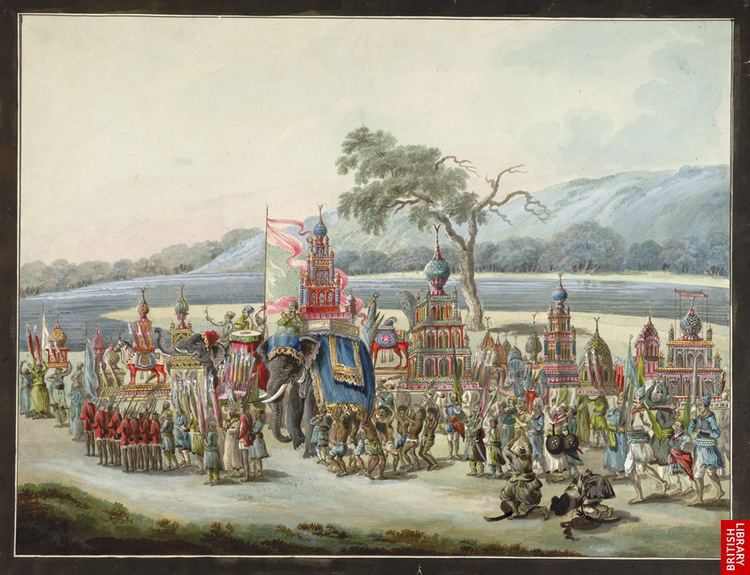Region Asia and Australasia | Reference 377 Inscription 2010 | |
 | ||
Ta'zieh or Ta'zïye or Ta'zīya or Tazīa, (Arabic: تعزية, Persian: تعزیه, Urdu: تعزیہ) means comfort, condolence. It comes from roots aza (عزو and عزى) which means mourning.
Contents
Depending on the region, time, occasion, religion, etc. the word can signify different cultural meanings and practices:
Ta’ziyeh as a kind of passion play is a kind of comprehensive indigenous form considered as being the national form of Iranian theatre which have pervasive influence in the Iranian works of drama and play. It originates from some famous mythologies and rites such as Mithraism, Sug-e-Siavush (Mourning for Siavush) and Yadegar-e-Zariran or Memorial of Zarir
Ta'zieh in Persian culture
In Persian culture it refers to condolence theater and Naqqali which are traditional Persian theatrical genres in which the drama is conveyed wholly or predominantly through music and singing. It dates from before the Islamic era and the tragedy of Saiawush in Shahnameh is one of the best examples.
In Persian tradition, Tazieh and Parde-khani, inspired by historical and religious events, symbolize epic spirit and resistance. The common themes are heroic tales of love and sacrifice and of resistance against the evil.
While in the west the two major genres of drama have been comedy and tragedy, in Persia, Tazieh seems to be the dominant genre. Considered as Persian opera, Tazieh resembles European opera in many respects.
Persian cinema and Persian symphonic music have been influenced by the long tradition of Tazieh in Iran. Abbas Kiarostami, famous Iranian film maker, made a documentary movie titled "A Look to Tazieh" in which he explores the relationship of the audience to this theatrical form. Nasser Taghvaee also made a documentary on Tazieh titled "Tamrin e Akhar".
Ta'zïye in Iranian Shiism
The appearance of the characteristic dramatic form of Persia known as the ta'zïyeMu'izz ad-Dawla, the king of Buyid dynasty, in 963. As soon as the Safavid Dynasty was established in Persia in 1501 and the Shiism of the Twelvers adopted as the official sect, the state took interest in theater as a tool of propagating Shiism.
Ta'zīya in South Asia
Shia Muslims take out a Ta'zīya (locally spelled Tazia, Tabut or Taboot) procession on day of Ashura in South Asia.
The artwork is a colorfully painted bamboo and paper mausoleum. This ritual procession is also observed by south Asian Muslims in,
In the Caribbean it is known as Tadjah and was brought by Shia Muslim who arrived there as indentured labourers from the Indian subcontinent.
Tabuik made from bamboo, rattan and paper is a local manifestation of the Remembrance of Muharram among the Minangkabau people in the coastal regions of West Sumatra, Indonesia, particularly in the city of Pariaman culminates with practice of throwing a tabuik into the sea has taken place every year in Pariaman on the 10th of Muharram since 1831 when it was introduced to the region by Shia Muslim sepoy troops from India who were stationed and later settled there during the British Raj.
During the colonial era in British India, the ta'zīya tradition was not only practiced by Shia Muslims and other Muslims but joined by Hindus. Along with occasions for Shia Muslims and Hindus to participate in the procession together, the Tazia procession have also been historic occasions for communal conflicts between Sunni and Shia Muslims and between Hindu and Muslim communities since the 19th century. These Tazia processions have traditionally walked through streets of a town, with mourning, flagellation and wailing, ultimately to a local lake, river or ocean where all the Tazia would be immersed into water.
Tazia
Like Western passion plays, ta'zia dramas were originally performed outdoors at crossroads and other public places where large audiences could gather. Performances later took place in the courtyards of inns and private homes, but eventually unique structures called tazias were constructed for the specific purpose of staging the plays. Community cooperation was encouraged in the building and decoration of the takias, whether the funds for the enterprise were provided by an individual philanthropist or by contributions from the residents of its particular locality. The takias varied in size, from intimate structures which could only accommodate a few dozen spectators to large buildings capable of holding an audience of more than a thousand people. Often the takias were temporary, having been erected specially for the mourning of Muharram. All takias, regardless of their size, are constructed as theaters-in-the-round to intensify the dynamic between actors and audience. the spectators are literally surrounded by the action and often become physical participants in the play. In unwalled takias, it is not unusual for combat scenes to occur behind the audience.
Takia-ye Dawlat, the Royal Theater in Tehran, was the most famous of all the ta'zia performance spaces. Built in the 1870s by Naser al-Din Shah Qajar, the Royal Theater's sumptuous magnificence surpassed that of Europe's greatest opera houses in the opinion of many Western visitors. This takia was later destroyed by Reza Shah.
